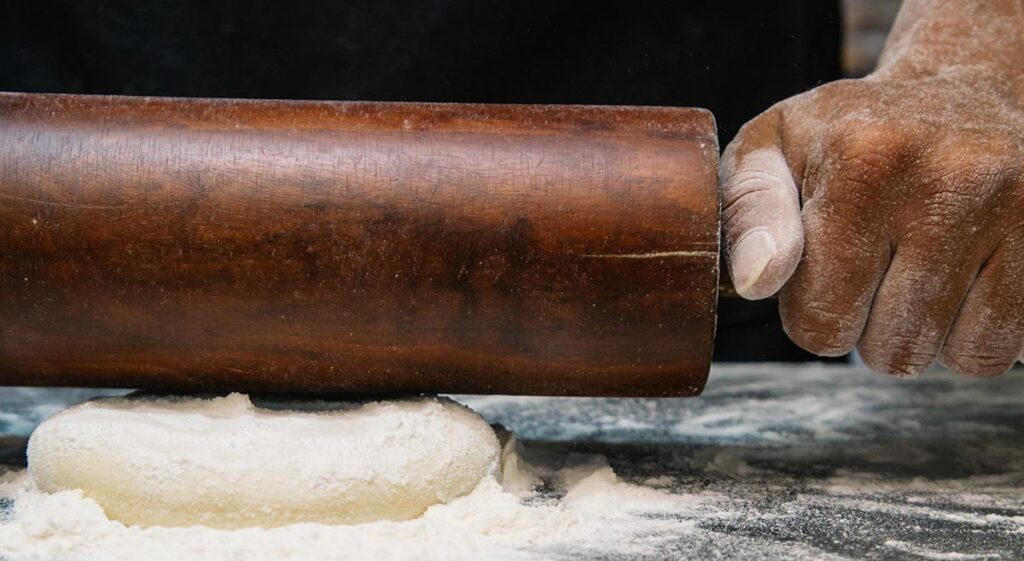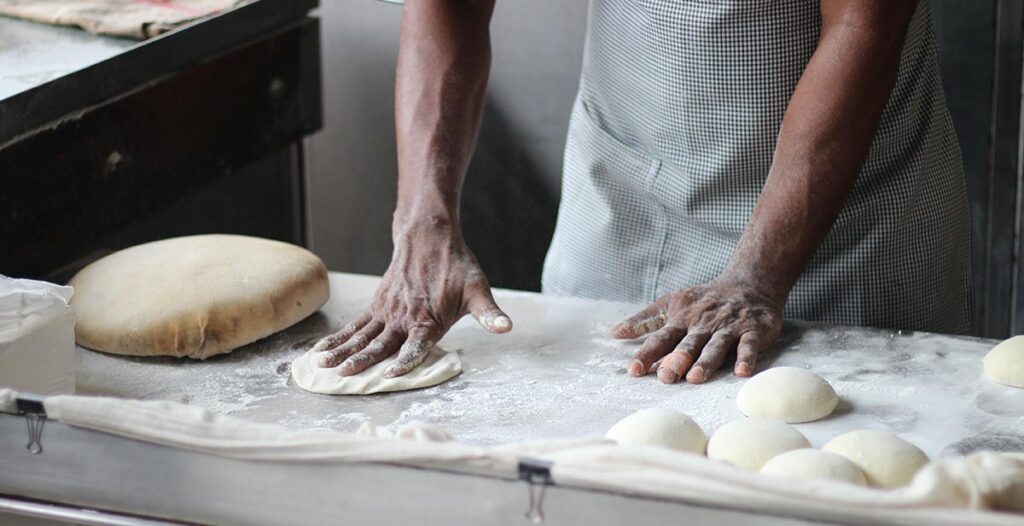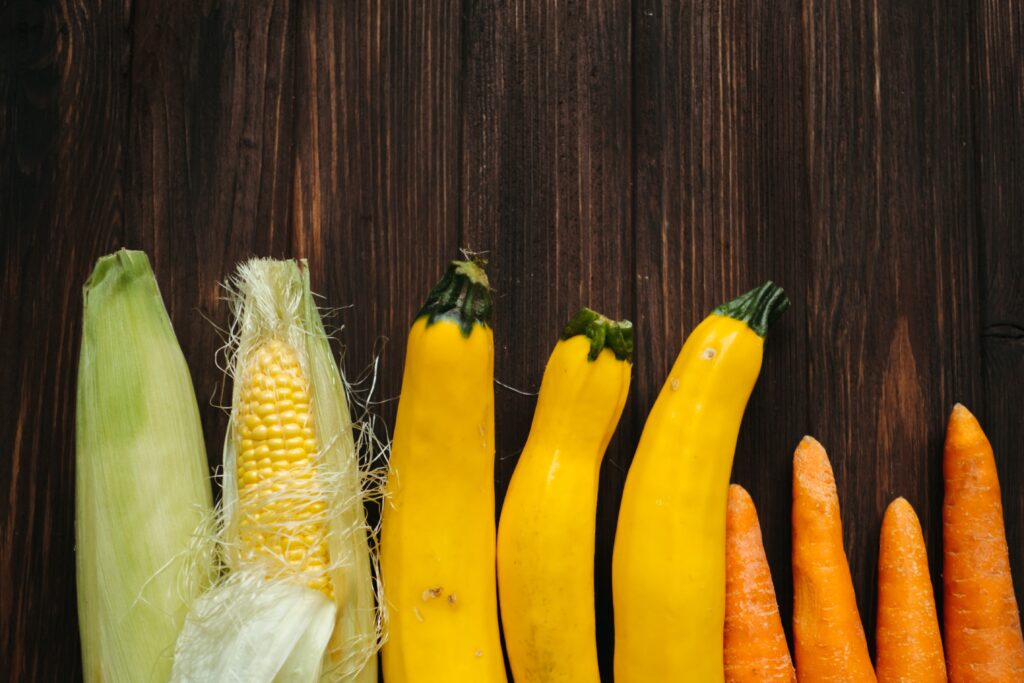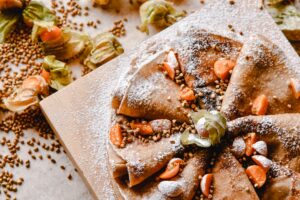A Guide to Gluten-Free Baking
by F. Watson, L. Bauer, C. Wysoki, and M. Bunning* (7/23)
Quick Facts…
- Baking without gluten can be challenging because gluten contributes important properties to baked goods.
- A wide variety of gluten free flours, starches and baking aids can be used to produce high quality baked products.
- Using combinations of various gluten-free products can enhance nutritional content.
- Making gluten-free baked goods with acceptable flavor and texture may require several trials.
What is Gluten?
Gluten is a combination of two proteins most often associated with wheat and wheat flour but gluten proteins can also be found in barley, rye, and other types of wheat, including triticale, spelt, einkorn, farina, kamut, farro, durum, bulgar, and semolina. Gluten proteins in wheat flours make dough elastic and stretchy, and trap gas within baked goods, providing a light, airy structure. Additionally, gluten can be found in products made with these grains like salad dressings, sauces, and beer.
The Food and Drug Administration (FDA) requires that all foods containing the nine major food allergens be clearly labeled on the packaging. This labeling law includes wheat but not gluten. Therefore, other gluten-containing grains, like barley and rye, are not required to be labeled. A package label stating “wheat-free” is not the same as “gluten-free.”
The FDA has also standardized the voluntary use of the labeling terms “gluten-free,” “free of gluten,” “no gluten,” and “without gluten” as containing less than 20 parts per million (ppm) of gluten. Unlike allergen labeling, food manufacturers do not need to label for gluten-free, but they may choose to use the term for consumer ease of label reading. As product ingredients may change, the best advice is to read the label carefully and contact the manufacturer if you are unsure about the gluten status of a food product.
Baking without Gluten
Baking without gluten (as found primarily in wheat-based flours) can be challenging because gluten contributes important properties to various types of baked products like cookies, cakes, pastries and breads.
- Cookies: Gluten development is not as important for cookies as it is for cakes, so gluten-free flours can be substituted with similar results.
- Cakes, pancakes, quick breads, other batter-based products: Batter-based products need gluten for its gas-retaining ability that produces a well-developed interior structure and a tender crumb. Replacing wheat flour with a combination of gluten-free flours and gums can help retain gas to develop structure.
- Bread: Bread is perhaps the most challenging gluten-free baked product to make because gluten provides structure, creates a tender crumb, and retains gas. With experimentation and practice, a combination of gluten-free flours and gums can be used to create a loaf with good volume, softness and texture.
- Pasta: Although it is not a baked product, pasta is usually made from hard wheat flour. The gluten component not only gives structure to the noodles, but also keeps the starch in the flour from leaching into the cooking water or becoming too sticky. When making pasta or similar products, these properties can be approximated with the use of gluten-free flours in combination with eggs and xanthan gum.

Gluten Replacement Products
A wide variety of gluten-free flours, starches and baking aids can be used in combination to produce high-quality baked goods and pasta. Recipes calling for 2 cups of flour or less are more easily adapted, especially those that use cake flour because it contains less gluten. Many of the alternative grains and pseudo-cereals commonly found in the marketplace are listed in Table 1. Pseudo-cereals are “false cereals” that are not derived from grasses (as are true cereals), but come from other plants that have seeds that can be used in the same manner as cereal-based grains. Several of these flours, including almond, can be made at home with a coffee grinder.
The most common binder in gluten-free baking is eggs. Eggs can replace many of the functions that gluten provides, such as binding, enhancing texture and helping set the structure of the final product.
White rice flour and starches usually can be stored in the pantry, but because of higher fat and protein content, purchase whole grain flours and meals in smaller quantities and store in the refrigerator or freezer. Due to the relatively short shelf-life, you should check for any off or disagreeable odors before using to determine if the flour has become rancid.
Regardless of gluten-free status, consumers should not eat raw batter or dough, made with flour because of possible contamination. Flour is a raw agricultural product with increased risk of harboring bacteria. Before the heating process of cooking or baking, these bacteria could cause illness. Follow safe handling procedures after contact with raw products or flour: wash hands, work surfaces, and utensils thoroughly after contact.
Flour Blends
Gluten-free flours are rarely a good replacement, cup for cup, of wheat-based flours. A blend of gluten-free flours is recommended to replicate the protein, fiber, and starch components as well as flavor and texture of the particular wheat flour being replaced.
Baking books and online resources frequently offer gluten-free flour blend formulations for use in making cookies, cakes, quick breads and yeast breads. The formula might include three or four different types of flours and starches and make 2 to 12 cups of blended flour. Flours with stronger flavors typically make up no more than 25 to 30 percent of the total blend and are balanced by neutral flours and starches. Stronger tasting flours (such as bean flours) generally are used in small quantities in recipes that feature delicate flavors. A higher percentage of these flours can be used in baked goods that include nuts, chocolate, or a high level of spice.
Flour blends for quick breads often contain 1/2 teaspoon xanthan gum per cup of flour while yeast breads contain 3/4 teaspoon per cup of flour blend.
Gums and Binders
The most common binder in gluten-free baking is eggs. Eggs can replace many of the functions that gluten provides, such as binding, enhancing texture and helping set the structure of the final product. Besides eggs, which are protein-based, two starch-based products often used to bind and thicken gluten-free baked products are guar gum and xanthan gum. These products are largely interchangeable and are used in small amounts (1/2 to 1 teaspoon per cup of flour) to add volume and texture to baked goods. In addition, water absorptive properties in fiber-rich seeds such as chia, flax, or psyllium can produce a gel to aid in binding and structure development.
Seeds can be used ground or whole, depending on the desired product outcome. Gums and binders are commonly available in large grocery stores, either in the baking aisle or natural foods section of the store.
Table 1: Profiles of Alternative Grains and Pseudo-cereals
| Gluten-free Flours & Starches | |
| Type | Characteristics |
| Amaranth | • Pseudo-cereal native to South America • Higher in protein, fiber and iron than most grains • Provides structure and binding capability • Has a pleasant, peppery flavor. Best used in combination with other gluten-free flours |
| Arrowroot | • Used as thickener and in baking similarly to cornstarch |
| Bean/Legume | • Legume flours include fava beans, garbanzo beans, soybeans • Good source of protein and fiber • Best used in combination with other gluten-free flours to balance taste and texture • Bean flours complement sorghum flour |
| Buckwheat | • Nutritious grain rich in B-vitamins, magnesium, dietary fiber and antioxidants • Strong, somewhat bitter flavor • Best used in pancakes or yeast breads in combination with neutral gluten-free flours |
| Chia (Salba) | • Like flax, ground chia seeds can add nutritional value to baked goods • Neutral in flavor • High in soluble fiber which allows gel formation. |
| Coconut | • Ground from coconut meat • High in fiber, low in carbohydrates • Extremely absorbent • Best used in small amounts, in combination with other flours, with additional liquids |
| Corn flour | • Used in breads, waffles, and tortillas |
| Corn meal | • Used in spoon breads and baking powder-leavened breads |
| Corn starch | • Neutral in flavor • Used as thickener and in baking for structure and tender texture |
| Flax | • Ground flax seeds increase nutritional value • High in soluble fiber which allows gel formation • Retains moisture and gives spongy texture to baked goods • Nutty, bold flavor • Adds color to baked goods |
| Millet | • Powdery consistency, color similar to cornmeal • Delicate, sweet flavor • Suitable for use in flatbreads and muffins |
| Montina (Indian rice grass) | • Milled from a grass native to Montana • High in fiber and protein |
| Nut | • Nut flours include almond, pecan, walnut, hazelnut, filbert, and chestnut • Contribute flavor and nutrition to baked products • Best used in combination with other gluten-free flours to balance taste and texture |
| Quinoa | • Pseudo-cereal native to South America • Good source of protein, folate, copper and iron • Mild, slightly nutty flavor Suitable for cookies, cakes and breads |
| Potato flour | • Neutral flavor • Blends well with stronger flavored flours |
| Potato starch | • Provides a light consistency to baked products • Helps retain moisture, combines well with eggs • Bland flavor, low in fiber and nutrients |
| Rice, Rice bran | • Comes in brown, white and sweet varieties • Best used when combined with other gluten-free flours and binders or gums • Neutral flavor • Sweet rice flour is used in pie crusts and as a thickener |
| Sorghum (milo) | • Tropical cereal grass native to Africa • Sweet, nutty flavor • Best when used with other neutral gluten-free flours and gums |
| Tapioca | • Starchy, sweet flavor • Adds chewy texture to breads • Used in blends to improve color and crispiness of crusts |
| Teff | • Small cereal grain native to Africa • Taste similar to hazelnuts • Very high in nutrients • Ability to gel makes it a good thickener |

High Elevation Gluten-free Baking
Baking at higher elevation (greater than 3000 feet above sea level) can be challenging when using traditional wheat flour recipes. Liquids evaporate faster and gases in cakes and breads expand quicker, requiring adjustments to ensure a good final product. When wheat flour is replaced with gluten-free flours these same challenges remain, although there are no set guidelines on how to successfully compensate for the elevation change.
Bakers are advised to experiment with recipes, first making any necessary adjustments for the elevation change and then altering the recipe further as needed to adjust for the properties of the gluten-free flours.
For assistance with high elevation baking, see the Colorado State University Extension brochure, High Altitude Food Preparation Guide.
Baking Tips
Gluten-free baking can be a trial-and-error process. Here are some tips that can help achieve successful results.
To Increase Nutrition:
- Use a variety of gluten-free flours in combination to maximize nutrition (Table 1).
- Use whole grain or enriched gluten-free flours. Enriched means that vitamins and minerals have been added.
- Substitute up to 1/4 cup ground flaxseeds plus 1/4 cup water for 1/4 cup flour in a recipe (flax will absorb more moisture).
To Increase Moisture:
- Add an extra egg, gelatin, or oil to the recipe.
- Honey or rice malt syrup can help retain moisture.
- Brown sugar often works better than white.
- Dough enhancers or vinegar improve tenderness and delay staling.To Enhance Flavor
To Enhance Flavor:
- Add chocolate chips, nuts, or dried fruits.
- Double the amount of spices.

To Enhance Structure:
- Use a combination of gluten-free flours and mix together thoroughly before adding to other ingredients.
- Add dry milk solids or cottage cheese into recipe.
- Use evaporated milk in place of regular milk.
- Add extra egg or egg white if product is too crumbly.
- Do not overbeat; kneading time is shorter since there is no gluten to develop.
- When using a bread machine, use only one kneading cycle.
Leavening:
- Starch flours need more leavening than wheat flours.
- Rule-of-thumb: start with 2 teaspoons baking powder per cup of gluten-free flour and adjust downward as need for elevation.
- If baking soda and buttermilk are used to leaven, add 1 1/8 teaspoon cream of tartar for each 1/2 teaspoon baking soda used to neutralize acid.
For better rise, dissolve leavening in liquid before adding to other ingredients or add a little extra baking powder.
Texture/Lightness:
- Prior to measuring, aerate flours and starches with a sifter that is used only for gluten-free flours or using a wire whisk. Combine and sift again (together) after measuring to improve the texture of the product.
- Hold gluten-free dough at least 1/2 hour (up to overnight) in the refrigerator to soften and improve the final texture of the product.
- In products made with rice flour or corn meal, mix with the liquid called for in the recipe. Bring to a boil and cool before adding to recipe to help reduce grainy texture.
Baking Pans and Utensils:
- Bake in smaller-than-usual portions at a lower temperature for a longer time (small loaf pans instead of standard size; use mini-muffins or English muffin tins instead of large muffin tins).
- Use dull or dark pans for better browning.
- Keep a separate, or dedicated, sifter to use only with gluten-free flours, to prevent cross-contact with gluten.
Freshness:
- Gluten-free baked goods can lose moisture and quality quickly. Wrap them tightly and store in the refrigerator or freezer in an airtight container to prevent dryness and staling.
- Store all gluten-free flours and starches in airtight containers to reduce moisture absorption.
- Refrigerate or freeze whole grain, nut, and bean flours and flour blends for freshness and quality, but bring to room temperature before measuring.
References
Belton, P. and Taylor J. 2002. Pseudocereals and Less Common Cereals. Springer-Verlag, New York.
Case, S. 2006. Gluten-Free Diet: A Comprehensive Resource Guide. Case Nutritional Consulting. Regina, Canada.
Fenster, C. 2007. Gluten-Free Quick and Easy. Penguin, East Rutherford, NJ.
Hagman, B. 2000. The Gluten-Free Gourmet Bakes Bread. Holt & Co., New York.
US Food and Drug Administration. Gluten-Free Labeling of Foods
Wenniger, MA. 2005. The Best-Ever Wheat and Gluten-Free Baking Book. Fair Winds Press, Beverly, MA.
Go to top of this page.






